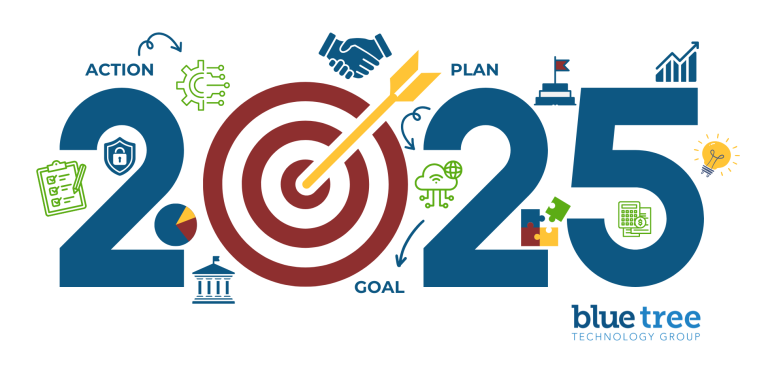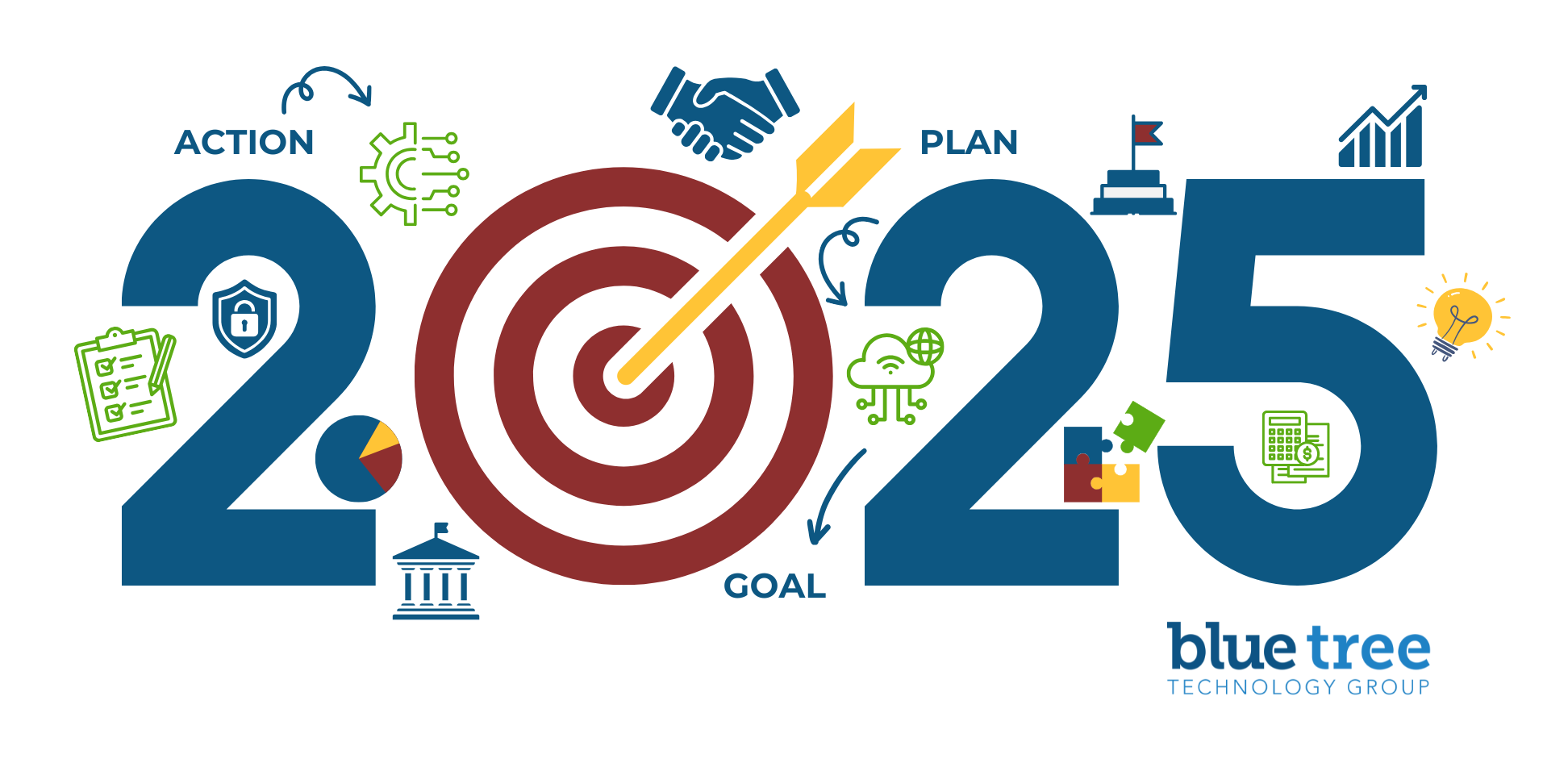
With 2025 fast approaching, many of our executive clientele are reflecting on past decisions and planning for the future.
At Blue Tree Technology Group, we take strategic planning more seriously than simply adopting new tools and trends. We find efficient and innovative ways to align technology with business goals.
In this article, I share some tried and tested tips for strategic IT planning, including gap analysis, budget review, contingency planning, and integrating new technology systems. This article is intended to be a light read, but will cover several aspects you might want to consider to begin working towards developing a strategic IT roadmap for 2025.
1. Review Current State
Before you make plans for the new year, look back on the previous year, reviewing the current state of IT systems, infrastructure, and objectives. Recognize the goals made and what was actually accomplished so you can make necessary amendments going forward. Don’t forget to celebrate even the small successes and milestones, as those moments often get lost in the bigger picture, and identify losses and failures transparently.
Below are areas to consider when planning for the new year:
- User Experience: Are your employees and customers benefiting from your tech innovation and accessibility?
- Cybersecurity Measures: Are you and your clients protected against potential threats?
- Software and Hardware: Are your existing systems up-to-date?
- Performance Indicators: Are your processes ensuring reliability, speed, and capacity required to support your business objectives?
When you understand what works for you in the present, you can easily identify gaps, mitigate redundancies, and pinpoint areas for improvement and investment in the future.
2. Aligning Technology with Business Goals
Technology is not an underdog; it should be the a leading player in your business strategy. Start by meeting key stakeholders and the leadership of your organization to discuss business priorities for the next year. These might consist of entering new markets, acquiring new entities, developing new products, improving customer experience, and/or introducing new systems and processes.
Answers to the following questions will help bridge the gap between your business goals and IT planning.
- What objectives do you plan on achieving in the next 12 months?
- What obstacles are proving challenging to your company?
- How can IT planning help achieve those goals?
For example, if operational efficiency is at the top of your list, invest in cloud computing solutions or automation tools to increase productivity and eliminate manual tasks.
3. Introducing New Technology Trends
The rise of technological innovation continues to surprise us, and the only way to survive this acceleration is to keep up with the latest trends. I’m not saying you have to run after every keyword, but you should be open to welcoming new technologies that complement your business goals.
Here are some upcoming trends to look out for:
- Data Analytics: When used effectively, data can be proved a valuable resource by providing insight into efficiency and growth.
- Cloud Computing: All businesses, irrespective of their size, are now able to acquire resources such as storage, software, and servers through a cloud computing service.
- Evolution in Cybersecurity: In 2025, threat detection, zero trust architecture, and endpoint detection will help businesses combat cyber threats.
- Artificial Intelligence: Most organizations are in the very beginning stages of trying to understand how to leverage AI to optimize their business. Those who are not finding small and big ways to put it into practice in 2025 will be outperformed by their competition in the years to follow.
4. Annual Risk Assessment
Did you encounter a data breach you weren’t technologically prepared for? Don’t let that happen in 2025! Treat cybersecurity as a priority; not an option.
You should be prepared to tackle cyber threats by installing protective systems to maintain customer privacy, safeguard vulnerable information, and avoid costly disruptions.
Your IT roadmap for 2025 should consider the following:
- Human error poses a major risk to your business. Ensure your employees are familiar with the best cybersecurity practices and can easily identify phishing attempts and external fraudulent activities.
- Identify loopholes in your existing systems and processes.
- Communicate actionable steps within your team in case of potential breaches.
- Systems like firewalls, multi-factor authentication, patch management, and end-to-end encryption help organizations secure their database.
The 2024 IBM Cost of a Data Breach Report revealed a 10% increase in breach costs from the previous year, resulting in the largest annual rise since the pandemic. This data indicates a potential increase in 2025 as well, and only businesses with strong defenses will be able to protect themselves.
5. Contingency Planning
Success and failure are unpredictable in the business landscape. However, your IT planning for the new year should cover areas for change, growth, and any mishaps.
Plan on scaling your operations next year? Embracing new technologies or navigating external challenges? A flexible IT plan will help you prepare for unpredictability.
- Automate Workloads: When you automate manual workloads, you save time and eliminate chances of error, enabling your team to focus on making high-value decisions.
- Advanced Solutions: Scalable solutions like modular software, cloud infrastructure, and subscription-based tools can boost productivity without major disruptions.
- Hybrid and Remote Models: Don’t let geographical barriers hinder your success. In 2025, hire the best talent from across the globe, but ensure your IT systems can maintain secure and seamless connections with remote employees.
6. Budget to Support Your IT Investments
Think beyond the next year. Perhaps draft a 3-year budget that supports your strategic planning. Start by identifying your top priorities. New IT infrastructure, vendor proposals, compensating your IT team, new projects, or investment in modern technologies can help you plan ahead of time and set an estimate of what you’re likely to spend in the future.
Involve your team to review your annual IT strategy and make budget recommendations on how IT can secure and sustain your future goals.
For an effective IT budget:
- Prioritize Investments that deliver maximum ROI
- Include all costs related to IT solutions, maintenance, implementation, and training.
7. Track Growth and Drive Results
A successful IT plan is not stagnant. Today’s business challenges and technology are changing every second, which means your strategy needs to be adjusted to new factors of success, as well. Make it tangible and delineate key performance indicators (KPIs) which will help in measuring the success of your annual IT strategy.
Consider the below KPIs:
- Are your existing IT investments delivering the expected ROI?
- Has user experience improved since the new installations?
- Are IT systems running smoothly with minimum disruption?
Frequently visit your IT roadmap to track progress and adjust strategies to make sure they align with future business goals.

Wrapping Up Your Annual IT Planning Effort!
Strategic IT roadmap planning and development is not a one-time practice; it must be continuous and long-lasting. At Blue Tree Technology Group, we follow this through routine meetings, budget analysis, IT audits, and endorsing new technology plans.
Additionally, we partner with clients by regularly looking for ways to assist them in improving productivity, enhancing security, and building a trusted business community to increase their leverage.
Whether leveraging our team, another trusted advisor, or managing strategic planning inhouse, by following these steps in 2025 and making them a crucial part of your strategic IT planning efforts, you can avoid future headaches that may arise from a lack of preparation. If you invest wisely and stay adaptable throughout the year, you’ll notice the impact your planning made – not just on IT but your entire organization!




